Announced this year for Canon’s new mirrorless EOS R system, the RF 85mm F2 IS Macro IS STM is a moderate-speed medium telephoto lens aimed at portrait and wedding photographers. Following the ultra-high speed RF 85mm F1.2L USM and the even more specialized DS version to offer a different, softer look to diffused backgrounds, this new f/2 addition to the range has an interesting set of features.
Although the conventional wisdom is to opt for a mid-range telephoto with the usual 0.85m minimum focus and modest 0.13x magnification, many photographers choose a 100-105 mm macro to use as a portrait lens instead. Combining a typical closer minimum focusing of around 0.3m and higher magnification up to 1x (1:1) with a true macro makes for a highly versatile lens. This not only allows tightly cropped headshots but also closeups on eyes and lips, or on jewelry such as earrings or wedding rings— little details conventional lenses can’t get near to.
With this new model, Canon has taken heed of this and designed a portrait lens with a 0.35m minimum focusing distance and a still useful 0.5x (1:2) maximum magnification.
Besides the close focusing, the lens has a “hybrid” 5-stop optical stabilizer that’s designed to specifically counteract the range of handheld movements when focusing so closely. Furthermore, when used with the integral stabilization of the EOS R5 and R6 bodies, Canon claims this increases the correction to an incredible 8 stops.
As a modern design, the optical construction is relatively complex. It consists of 12 elements arranged in 11 groups, including the stabilization optics and one UD (ultra-low dispersion) glass element for chromatic aberration correction. In addition, it has Canon’s anti-reflective Super Spectra Coating to reduce flare and ghosting, and 9 aperture blades with a rounded opening for more attractive-looking circular highlights.
An STM-type focus motor handles autofocus by extending the front group. The lens supports dual-pixel CMOS AF tech and provides “focus-by-wire” manual override using the wide rubber-covered focus ring.
Measuring 78 x 90.5 mm (3.07 x 3.56″), the Canon 85mm F2 Macro IS STM is available now at a suggested retail price of $699/799€.
Key specifications:
-
12 elements in 11 groups
-
Super Spectra coatings
-
Nine-blade circular aperture
-
67 mm filter thread
-
Minimum focus distance: 0.35m (1.15 ft.)
-
Maximum magnification 0.5x (1:2)
-
Weight: 500 grams (1.1 lb)
Overall lens image quality
We tested the Canon RF85mm F2 Macro IS STM on the 30 MP Canon EOS R, the first in the series, though it has since been usurped as the highest-resolution model in Canon’s mirrorless lineup by the relatively new 45 MP EOS R5. Together the lens and camera achieved a high rating for optical quality, above both the RF 50mm F1.2L USM and the RF 28-70mm F2L USM on the same 30 MP Canon EOS R. As you might expect from Canon’s L-series, both of those those lenses are excellent performers with high optical quality.
Particularly impressive was the new RF 85mm F2 Macro IS STM’s high sharpness at all apertures. Peak sharpness levels of 26 P-Mpix mean it’s well matched to the EOS R sensor, and that score will only increase on higher-resolution models such as the 45 MP Canon EOS R5. The new lens also has low lateral chromatic aberration throughout, as well as negligible distortion and relatively low vignetting at the initial aperture. Given the relatively accessible price of the new lens (certainly compared to that of the RF 50mm F1.2L and the RF 28-70mm F2L), it’s a very good to excellent performer.
Image quality compared to competitors
Click here to open our interactive DxOMark lens comparison tool.
We’ve highlighted some of the best-performing 85 mm lenses from other manufacturers, a few of the more pricey f/1.4 variants, and the Sony 90mm F2.8 Macro G OSS, which we have tested.
As the DXOMARK score is derived from the combined camera sensor and lens performance, the higher spatial resolution of the Sony A7R IV and Nikon D850 favors those lens and camera combinations. After we test the higher-resolution 45 MP Canon EOS R5, which more in line with the Nikon D850 and the Sony A7 R IV up to a point, we would expect the RF 85mm F2 IS STM to move up the rankings with a higher score. However, it is still interesting to see just how well the Canon EOS R and RF 85mm F2 Macro IS STM compares with those models.
The new RF 85mm F2 Macro IS STM clearly surpasses the older EF 85mm F1.8 USM. The main areas of improvement in the newer model include higher sharpness (for a similar 30 MP sensor) and slightly lower levels of lateral chromatic aberration and vignetting. Transmission has improved as well. From our tests, the 1/3-stop difference at maximum aperture is just 0.1 EV slower than the older model (T2.2 vs.T2.1), which wouldn’t be noticeable in use.
While we tested the RF 85mm F2 Macro IS STM on the 30 MP Canon EOS R, we will be testing the lens on the Canon EOS R5, so when that data is available it will be worth checking the performance with our interactive DXOMARK lens ranking tool here.
In-depth comparisons
For a more detailed look at the optical performance of the RF 85mm F2 Macro IS STM on the Canon EOS R, we will compare it with the popular Sony FE 85mm F1.8 lens, which is a similar offering to the Canon lens. While we haven’t yet tested it on the 24 MP Sony A7 III, which would be a good choice for comparison, we have tested that lens on the current 60Mp Sony A7R IV. However, because of the much higher pixel count of that camera we’ve deviated from our usual presentation of data and chosen to compare that lens for sharpness on the older 36Mp Sony A7R, as it has a similar, though still slightly higher, spatial resolution to the EOS R.
We’ll also look at the Tamron SP 85mm F1.8 Di VC USD on the older 36Mp Nikon D800E for the sharpness comparison, for the same reasons as above, as well as the current 45 Mp Nikon D850 for the other parameters. It is worth noting if you have the stabilized Tamron lens as an EF-mount version it can be fitted to the 30 MP Canon EOS R using the Canon EF-EOS R mount adapter.
Bear in mind that the slightly higher-resolution sensors of these rival cameras will positively influence the sharpness results. However, using our lens ranking tool here, you can compare these lenses for sharpness on the current Sony A7R IV and the Nikon D850, to see the effect that sensors with higher spatial resolution has on the results. The data highlights the importance that camera selection makes on the final result.
Sharpness
Despite the slight advantage that the rival makers’ lenses have on the higher-resolution sensors in this comparison, the Canon RF 85mm F2 Macro IS STM lens still has very high levels of sharpness right across the frame, and that’s particularly noticeable at wider apertures. At the initial f/2 aperture on the RF 85mm F2, the Canon combination is actually sharper than the Tamron on the Nikon D800E in the center, though that particular lens is sharper in the outer zones, most likely due to some field curvature. It’s no surprise to see that the Sony combination is sharper wide-open, but that’s only in the center, and edge performance is actually lower than the Canon RF 85mm F2 Macro IS STM on the EOS R.
With all three at f/2, things aren’t that much different (as you might expect), but at f/2.8 and f/4 the Tamron and the Sony (to a lesser degree) are slightly sharper than the Canon at all points across the frame. Given the slightly higher spatial resolution of those two cameras, though, that’s not a surprise.
None of the lenses have a significant amount of astigmatism, with the Canon RF 85mm F2 Macro IS STM and the Sony optics being pretty similar. The Tamron, however, is particularly effective at keeping it under control. What’s more surprising is that despite the similar spatial resolution sensor of the Sony and Nikon cameras, the Tamron appears well matched on the D800E and pulls ahead in sharpness over the Canon and the Sony combinations from f/5.6. Meanwhile, the sharpness of the Canon pairing is very similar to the Sony combination, which given the disparity in sensor resolutions, suggests the Canon RF 85mm F2 Macro IS STM is likely to be the sharper lens. We’ll know for sure after testing the Canon EOS R5.
Chromatic aberration
Moderate-speed lenses like this tend to have lower lateral chromatic aberration (LaCA) than their faster counterparts but, like them, it is still usually higher at their widest aperture. Admittedly, the Canon RF 85mm F2 Macro IS STM should have a very slight advantage over the f/1.8 lenses in this comparison when wide-open, but the Canon has extremely low levels anyway. There’s a slight surge right in the corner, but even then it maxes out at 2.5µm at the extreme corner (100% field position). The Sony and Tamron are also well corrected for lateral chromatic aberration, but they can’t match the Canon. At f/2, both the Sony and Tamron peaked at 4µm at the same position— sttill low, but considerably less impressive when you look at the profile across the frame (see below).
When stopping down, tests show the Sony actually gets a little worse, but the Canon continues to exhibit very low levels of LaCA. It may just be visible on high contrast edges in the outer zones, but it is so well controlled that it would take a concerted effort to find it.
LaCA is measured from the center of the frame at the left (0% field position) to the extreme corner of the frame (at 100%) to the right. Canon uses a correction profile for RF lenses which can be turned off in-camera. However, our results show the uncorrected result, so LaCA may not be visible at all in out-of-camera JPEGs or in supported RAW files processed in image editing software.
Geometric distortion
Mid-tele lenses like this don’t usually have much in the way of distortion, if any, but the Canon 85mm F2 Macro IS STM has some pincushion, measured at 0.3%. It’s not usually a problem in portraiture, so long as there are no known straight edges that are both parallel and close to the edge of the frame. By contrast, the Sony FE 85mm F1.8 has an equal amount of distortion (-0.3%), but it is the simple barrel type, where straight lines close to the edge are bent outwards away from the center. Both types are easy to correct in software if it’s not picked up in-camera with built-in lens correction profiles. We’ve presented the results here without any correction applied. The best of three in this comparison is the Tamron, with just a tiny amount of barrel distortion (-0.1%) that isn’t likely to be noticeable.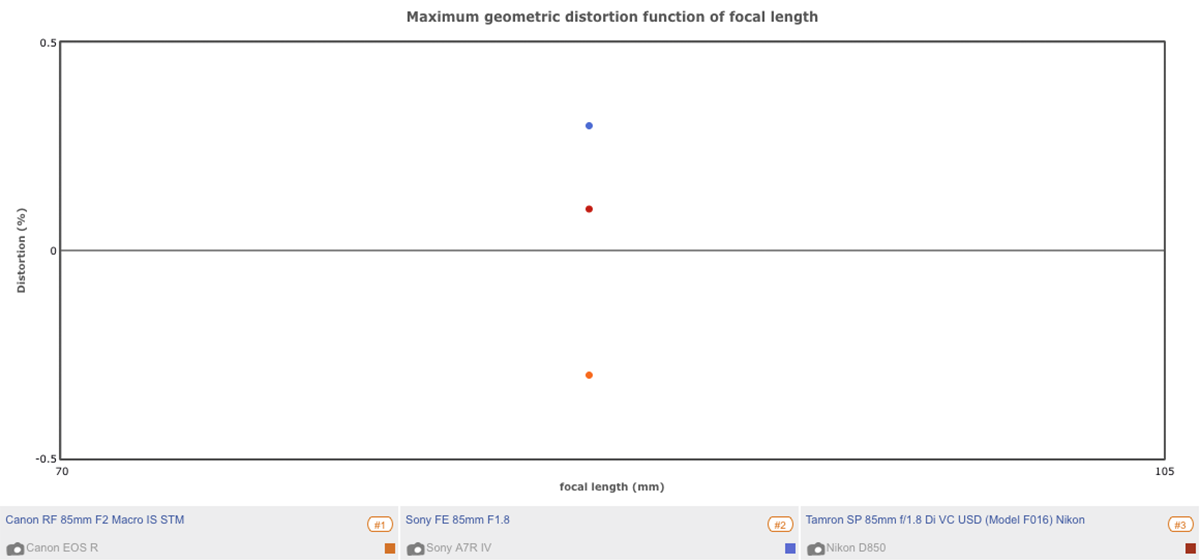
Vignetting (corner shading)
Even moderate-speed lenses display the effects of vignetting, which results in the darkening of the image towards the corners of the frame; some is visible for all three lenses, despite their adoption of lens correction profiles to reduce the effect in-camera. The data presented here shows the uncorrected amount, before the profile is applied. In theory, the 1/3-stop difference in maximum aperture is likely to give the Canon RF 85mm an advantage when comparing all three wide-open, and it does in practice.
When we compare all three at f/2, the Canon still has the least vignetting overall; however, the Tamron is very close. While the Tamron has the larger central area free of any vignetting, it reaches -1.6 EV right in the extreme corners of the frame and is visually more noticeable. While the field maps give a better visual representation of the effect, if you look at the graph below, the Tamron has the steeper slope, representing the falloff towards the corner. The Canon and Sony share a similar-sized central core that is free of vignetting, with the latter displaying heavier vignetting into the corners, measured at -1.9 EV at its peak, against -1.4 EV for the Canon.
More importantly perhaps is how quickly the lenses reduce the vignetting when stopping down, and it is the Canon lens that eliminates all traces first. Some slight vignetting remains at f/2.8, but there’s no appreciable darkening by f/4. The Tamron follows with negligible vignetting a stop later at f/5.6, but the corners in the Sony are never really free of some traces of it.
Transmission
From our tests, the Canon RF 85mm F2 Macro IS STM is a high-transmission lens, measured at T2.2 (just -0.2 EV less than the calculated aperture value). That’s just -0.1 EV slower than the Tamron SP 85mm F1.8 Di VC USD, which isn’t likely to be noticed in typical use. The Sony FE 85mm F1.8 is slightly faster (or brighter) at T2.0, but it’s only +0.2 EV faster than the Canon. Evidently the Canon has the most efficient transmission of the three, but at this level there’s not much among them in terms of lens speed or brightness.
Conclusion
After the introduction of the ultra-fast and somewhat esoteric RF 85mm F1.2L models for Canon’s new EOS R system, the more modestly priced and compact Canon RF 85mm F2 Macro IS STM is likely to placate most detractors of those early L-series who cited cost and weight as barriers to entry. As the RF mount equivalent of the highly regarded EF 85mm F1.8 version, the new lens has some interesting benefits such as stabilization and close focusing. Both features will appeal to wedding photographers, but it is the very high optical quality that will likely make this particular lens stand out and earn its place as the true replacement for the older EF version.
Admittedly, there are some points that may make potential purchasers pause, such as the slower maximum aperture, front barrel extension, and the adoption of an STM over the usually faster USM, but few can deny that this lens is an appealing alternative to those costly L-series models.
In this review, we have compared the Canon RF 85mm F2 Macro IS STM mounted on a Canon EOS R to its closest rivals from other brands. Remember that those lenses may be used on different cameras or, in some cases, on different camera systems using different mounts, so those comparisons are not strictly applicable.
As usual, you can create your own comparisons and in-depth analyses using our interactive image lens comparison tool.


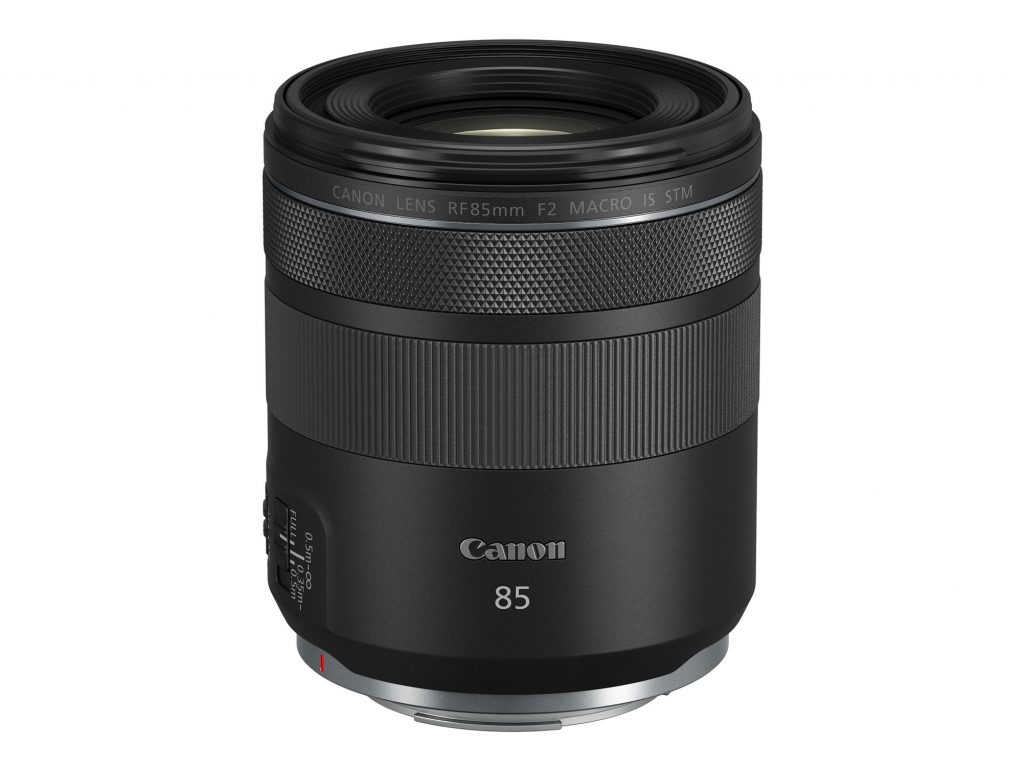



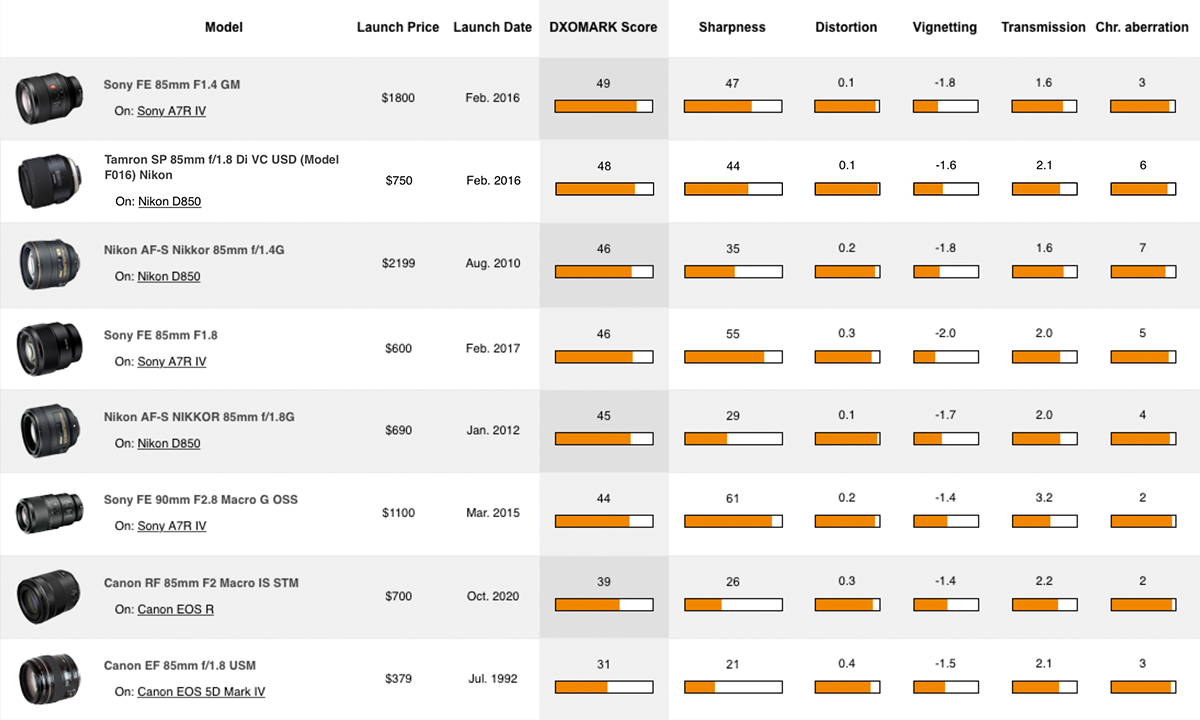
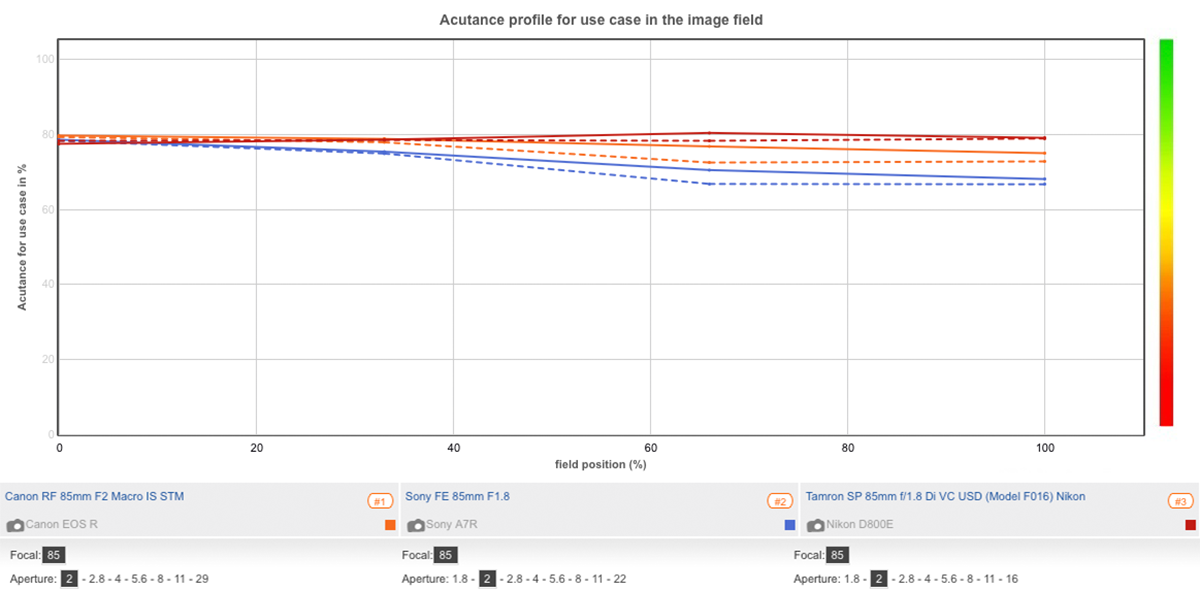
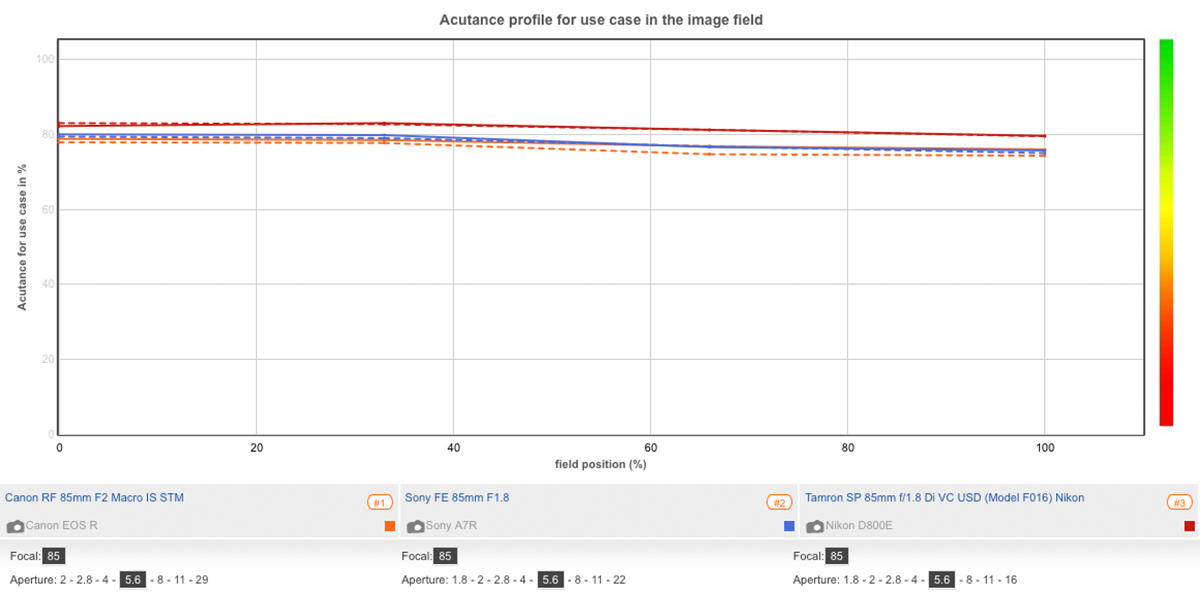
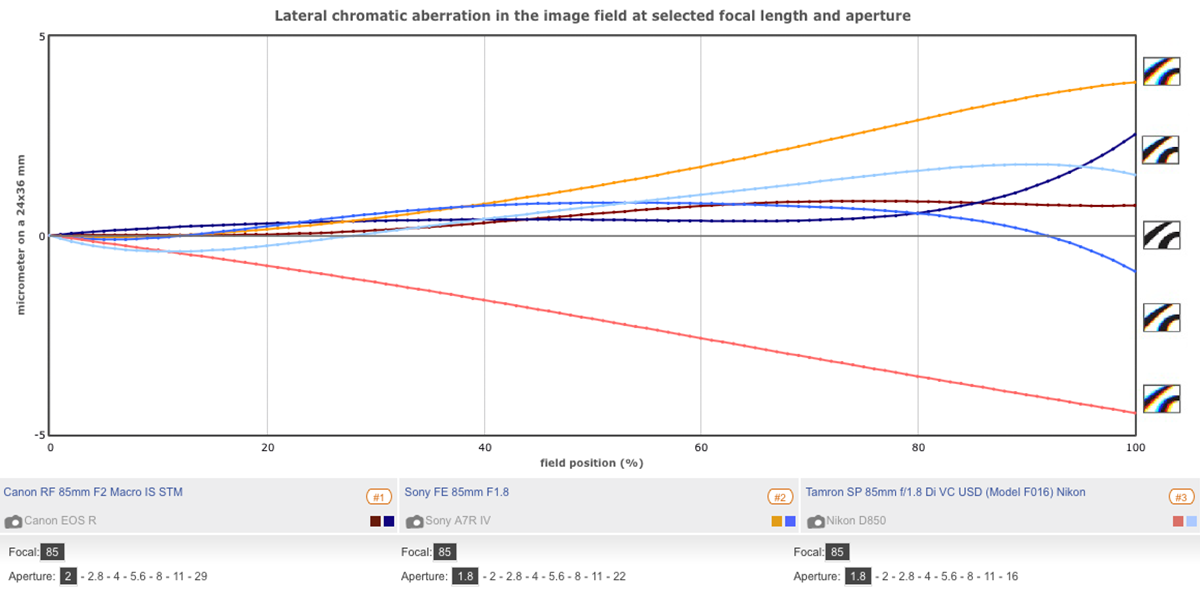
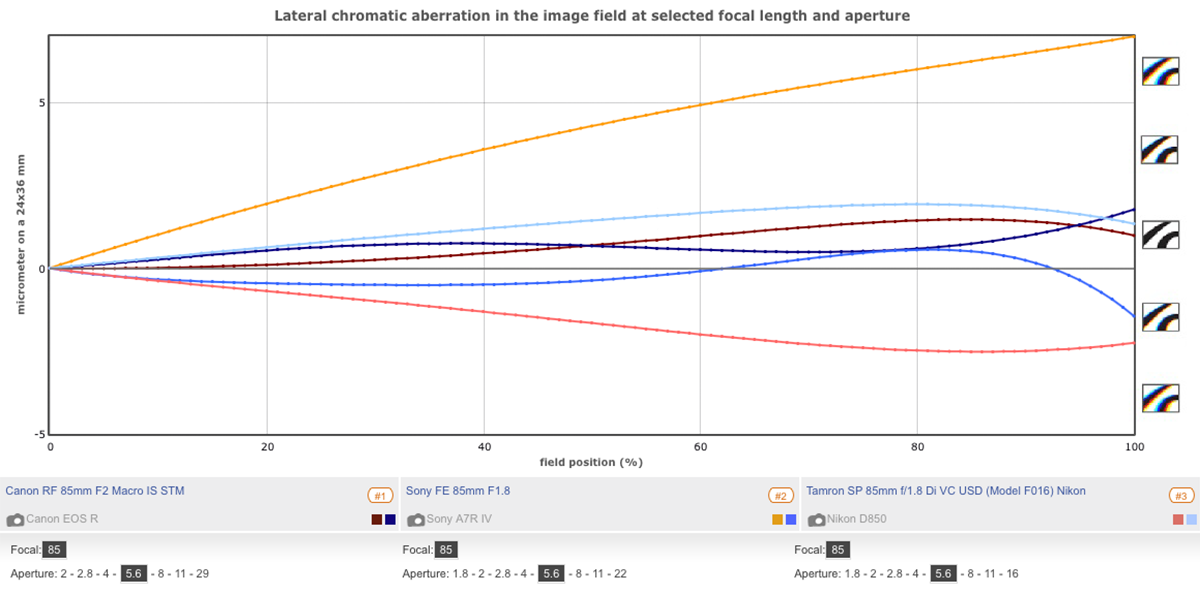
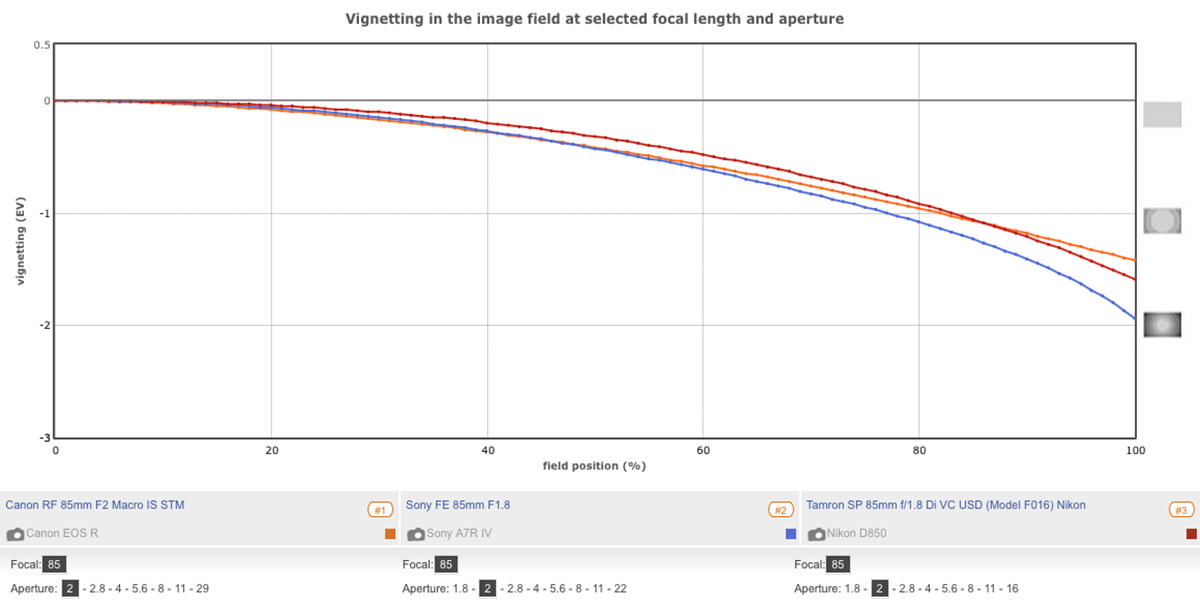
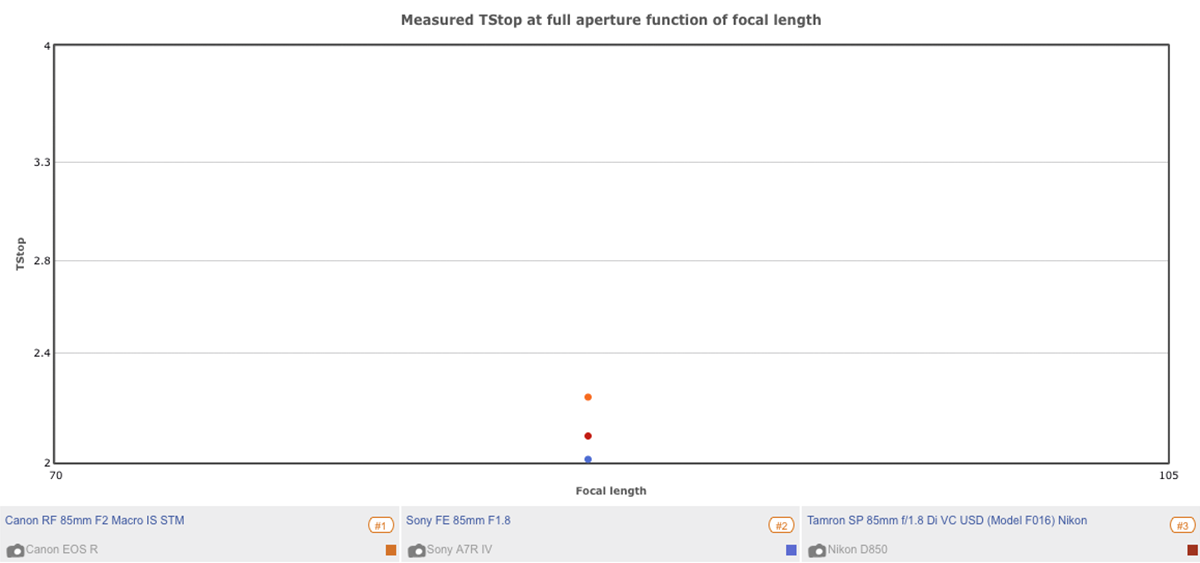
DXOMARK encourages its readers to share comments on the articles. To read or post comments, Disqus cookies are required. Change your Cookies Preferences and read more about our Comment Policy.